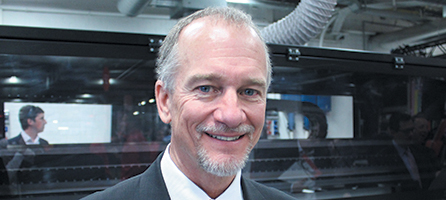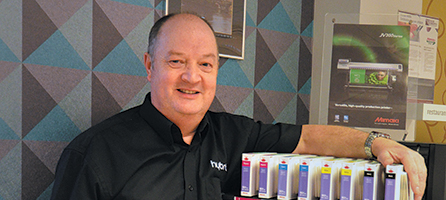
Robin East, group director, CMYUK
Ten years ago I can see how this question may have been up for debate, however, certainly in the case of EFI Vutek printers, registration and pass is incredibly accurate, so there is really no argument to be had.
Hybrids allow such a huge amount of freedom to produce a far wider range of products and applications. It is so much more versatile than a rigid bed, as it allows you to switch between roll-to-roll and rigid printing within a couple of minutes.
You are able to print on so many different materials, including self-adhesive vinyl, wallpapers, polyester textiles, dibond, acrylic; the list goes on and on. This enables printers to switch from one job to the next quickly and efficiently, fulfilling the majority of their customers’ demands. All of this without having to compromise on quality.

Hybrids allow such a huge amount of freedom to produce a far wider range of products and applications”
We call hybrids the Swiss Army knife of the trade. It is a jack of all trades, yes, but a master of many. A good example of the benefits our EFI hybrid systems have brought to sign-makers is Fastsigns Kingston Upon Thames.
After investing in an EFI H1625 LED they were able to print direct to foamex and dibond at a more competitive rate, giving them an edge over competitors, without giving up roll-to-roll capabilities when it is needed.
It has radically changed the way they work day to day, cutting vinyl and laminating cost dramatically and speeding up production time. They are now able to create low-cost point-of -sale material and have had a lot of call for printing colour-white-colour for double-sided window graphics. The H1625 was also perfect for them as it lowered their ink costs. It was a great investment, proved by the very positive impact it has had on their business.
High flexibility

Steve Collins, product marketing and channel manager, Agfa Graphics
We have both types of UV flatbed technology within our range of Anapurna and Jeti product portfolio and it is the hybrid presses that are our biggest sellers across all segments of the marketplace. This is because they offer the widest application range on one single machine. Hybrid UV technology is very flexible for handling all types of incoming jobs, are less restricted in sizes, and allow for a wider range of applications including flat-to-flat, roll-to-roll, but also roll-to-flat.
Objections from the past concerning front to back registration and overall levels of quality and speed are no longer valid. Today’s hybrid systems are well tuned to handle both rigid and roll-to-roll media without any speed drop, capable of offering automation and thus raising productivity and reducing waste and idle times. When combined with our Asanti workflow software, there are a host of features to assist in helping to reduce substrate changeover, avoid productivity down-time by allowing easy grouping of jobs, colour management, and job planning tools, all designed to reduce the overall makeready process.

If we analyse who buys our hybrid machines, we see a wide cross section of printing companies from commercial printers and sign companies to screen printers”
It is also worth noting our Asanti software works in perfect harmony with our Agfa made, Thin Ink Layer technology, thus allowing for one of the lowest level of ink consumption ROI’s in the marketplace, this gives the hybrid technology all the features and benefits required for today’s diverse workloads.
On a final note, if we analyse who buys our hybrid machines, we see a wide cross section of printing companies from commercial printers and sign companies to screen printers. There isn’t one particular type of company. As mentioned previously, because the hybrid concept offers such a high level of flexibility, the technology appeals to a wide range of business models.
Some limitations

Christopher Martin, business manager, Printmax
Both. A lot of Printmax customers have had huge success from the use of wide-format hybrid printers and it has certainly helped them develop their businesses with an ability to print direct-to-substrate.
Wide-format hybrid printers tend to be at a price point nearer the lower end, in comparison to true flatbed printers, enabling the customer to take a step up from roll-to-roll printing to direct-to-substrate printing, without the huge financial commitment of a true flatbed printer. Users will benefit from the versatility of flatbed and roll-to-roll print options in a single device—if production space is an issue, then a hybrid printer could be the right answer.
The success Printmax customers have had with the hybrid printers has in turn seen a lot of upgrades from the hybrid printer to true flatbed—proving the need for direct-to-substrate capabilities.

If production space is an issue, then a hybrid printer could be the right answer”
On the other side of the coin, many of our customers want a dedicated roll-to-roll to maximise the quality of specific applications. Lincolnshire-based LR Designs is a good example, they recently invested in a Mimaki CJV150, which has ten ink colour options, including silver, orange, light black, and white inks. Lee Rudd at LR Designs was interested in specifically printing orange for KTM motorbikes. Instead of opting for a hybrid, they went for a more advanced roll-to-roll system and can now hit faster speeds of 56.2sq m/h, and can hit KTM orange.
I would agree with the argument that hybrids are a ‘jack of all trades, master of none’ as well, within reason. There are limitations to printing lightweight board, roll-to-roll materials and you do not have the ability of printing heavier board, such as ACM and acrylic, so you do not get the full capabilities of a true flatbed printer.
There is still a market for wide-format hybrid printers and it is something that print production houses will still benefit from—providing the understanding of its limitations are there, wide-format hybrid printers have a place in the print industry.
Two heads are better...

John de la Roche, national sales manager, Hybrid Services
This is certainly a very interesting subject of discussion, and one I have debated many times over the years. The answer is two-fold. There are of course highly-respected wide-format print technology developers, that have made it their business to develop very reliable and high-quality hybrid systems that are capable of being masters of both flatbed and roll-to-roll printing. The issue here is price; to produce a system that is a ‘true hybrid’ is very expensive, and to maintain them can often be more expensive than systems that perform either roll-to-roll or flatbed.
There are also hybrid systems that are ‘jacks of all trades’ as you suggest, as they sacrifice the highest levels of quality and productivity to provide a two in one system at a more affordable price point. In the early days there were quite a few failed products, but cost-effective hybrids really have come on leaps and bounds. These also have their place of course, in smaller businesses severely limited on space that are not producing large volumes.
Mimaki has a strong contender in the hybrid space with the UJV-160, and we have a lot of installations in businesses that need its specific capabilities. My advice though, if space and budget allow, is to go for two separate devices. Hybrid Services has developed a very attractive package in this respect, as we can bundle systems such as the Mimaki JFX200 flatbed and roll-fed JV300 printers together.

My advice though, if space and budget allow, is to go for two separate devices”
There are some very clear advantages to this approach. The first is that your productivity is increased significantly, and you are not sacrificing any quality. In addition, a key challenge for many sign-makers today is they cater for such a diverse range of customers, and not many will accept the excuse: “Sorry I can’t deliver your hoarding panels today because my hybrid is tied up producing banners for another customer.” With these two systems affordably packaged together you can cater for a more diverse range of work in the same time frame. Finally, if one part of your product portfolio is really taking off, say doing graphic panels for construction sites, then you can upgrade your flatbed element, without having to touch the roll-to-roll.
Ultimately, this debate has been running since the first print and cut systems. I remember a customer saying: “So, these new print and cut devices, I don’t understand, you can’t print when you are cutting, and you can’t cut when you print. Why should I buy one, I already have a cutter?” The same is true of hybrid printers, they are right for specific circumstances at the lower end, or if you have the budget and workload they can be effective for more industrial set-ups.
Your text here...